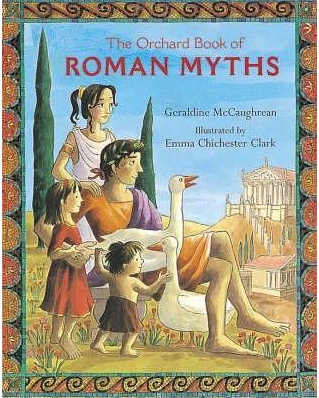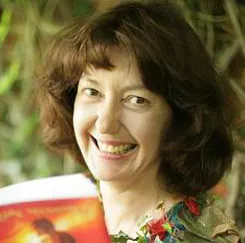Title of the work
Country of the First Edition
Country/countries of popularity
Original Language
First Edition Date
First Edition Details
Geraldine McCaughrean, Orchard Book of Roman Myths. London: Orchard Books, 1999, 96 pp.
ISBN
Genre
Illustrated works
Mythological fiction
Myths
Target Audience
Children (Children ages 9–12 )
Cover

Jacket cover for The Orchard Book of Roman Myths (c) Emma Chichester Clark, permission granted by the Laura Cecil Agency (Hachette, 1999).
Author of the Entry:
Allison Rosenblum, Bar-Ilan University, allie.rose89@gmail.com
Peer-reviewer of the Entry:
Lisa Maurice, Bar-Ilan University, lisa.maurice@biu.ac.il
Elżbieta Olechowska, University of Warsaw, elzbieta.olechowska@gmail.com

Courtesy of the Author.
Emma Chichester Clark
, b. 1955
(Illustrator)
Emma Chichester Clark is a British children's illustrator. Chichester Clark has been writing since she was five. She grew up in the Irish countryside and started illustrating at age 16. She trained in Graphic Design at the Chelsea School of Art. Originally rejected from the Royal College of Art, she began to focus on adult narrative work and, once accepted at the RCA, she switched back to illustrating children’s books. As well as collaborating with authors, Chichester Clark writes and illustrates her own picture books, notably the highly successful Blue Kangaroo series (Andersen Press Ltd.). She also won the Mother Goose Award as the most exciting newcomer to children's book illustration in 1988 for her illustration of Listen to This (1987). Chichester Clark is also writing and illustrating her own children’s books while collaborating with other authors.
Sources:
Official website (accessed: July 4, 2018).
Profile at the literature.britishcouncil.org (accessed: July 4, 2018).
Bio prepared by Allison Rosenblum, Bar-Ilan University, allie.rose89@gmail.com and Sonya Nevin, University of Roehampton, sonya.nevin@roehampton.ac.uk

Courtesy of the Author.
Geraldine McCaughrean
, b. 1951
(Author)
McCaughrean is a British novelist who currently resides in Berkshire, England. She is a prolific writer, who wrote of over 170 books – mostly children’s books but also several historical novels for adults. She won numerous awards for her books. In addition she also wrote a play for the radio and stage-plays. She grew up in North London and studied at Christ Church College of Education, Canterbury.
McCaughrean was the only author who won the Whitbread Children’s Book Award three times; she won it for her children’s novels: A Little Lower than the Angels (1987), Gold Dust (1993) and Not the End of the World (2004).
Sources:
Official website (accessed: May 28, 2018).
Profile at the literature.britishcouncil.org (accessed: May 28, 2018).
Bio prepared by Ayelet Peer, Bar-Ilan University, ayelet.peer@gmail.com
Questionnaire
1. What drew you to writing / working with Classical Antiquity and what challenges did you face in selecting, representing, or adapting particular myths or stories?
I loved the Classic myths as a child, though the books were a bit dull, illustrated with Greek statuary or Roman urns. There was a resurgence of interest in publishing them for children at the time I was newly surfacing as an author, so naturally I leapt at the chance to retell them. The illustrations were a lot better this time round.
The choosing of stories is largely guided by which are best known and (especially nowadays) those which feature on the National Curriculum. That, in turn, is largely guided by which are not too salacious or amoral. The Greek myths win out every time in terms of what the publishers choose to publish and what the schools choose to teach. I am particularly fond, however, of the Epic of Gilgamesh and like to harp on about that whenever I get the chance.
2. Why do you think classical / ancient myths, history, and literature continue to resonate with young audiences?
It is one of the few chances children get to be treated like adults. Since the stories were originally told to a diverse audience, and they are distinctly not "kiddies’ stories", young readers/listeners are for once given a glimpse of adults (and gods) behaving badly, death, battle, love, fate and so on, as well as identifying with heroes, superhuman beings and adventurers, all in a heady, sun-and-sea setting. Other "educational" retellings I am asked to write (such as fairy tales) come with a prohibition list of no-nos – knives, soldiers, witches, religion, war, sex, alcohol... All of that goes out of the window with Myth because (of course) such things are the substance of Myth. They are also the substance of Life and there are important things to be said about them – passed on from one generation to the next by means of story.
The sheer strangeness of times-long-gone are intriguing to children. I have never seen the need for "contemporary relevance" when it comes to entrancing children with Story. They can, after all, dart imaginatively through Time and Space with more ease than adults, and relish unquestioningly the most mind-boggling fantasy without turning a hair.
3. Do you have a background in classical education (Latin or Greek at school or classes at the University?) What sources are you using? Scholarly work? Wikipedia? Are there any books that made an impact on you in this respect?
I’m no classicist. I did do Latin to O-level at school, but none of it has stuck unless residually in my spelling. I wrote a collection of 101 Myths and Legends from Round the World which helped me see "Classical" myth in its global context, and how its influence travelled far farther afield than the Greeks themselves ever did.
For sources, I don’t go to other children’s versions, for obvious reasons, but to Robert Graves or adult encyclopaedias of Mythology or Penguin versions of the epics.
4. Did you think about how Classical Antiquity would translate for young readers?
The arrant misogyny and gynophobia of the ancient Greeks are an undoubted problem. Almost every monster is female, almost every female is scheming or dangerous, a snake under her skirts, or only there to be conquered and bedded. Heroes like Hercules get through droves of women – and then there are his dubious shield-bearing beloved boys...
I do an exercise in schools whereby Perseus goes off to kill Medusa clad in all the language of heroism and admirable virtues... and then, as the kid raises his sword to strike, I point out that, by the way, he has abandoned his mother in her hour of need because he fell for a flattering trick and boasted he could kill the gorgon, so has flown off to kill a woman he has never met and knows nothing about – a woman who was transformed and deformed through no fault of her own, and – ooo – who happens to be pregnant with twins when Perseus slashes her head off her shoulders. It’s a nice exercise in "viewpoint". ... But of course in retelling the myth in writing I can’t do that. I have to be true to the stories I loved myself as a child, and trust to the appeal that has kept them alive and popular for thousands of years.
5. Writers are often more "faithful" to originals in adapting its spirit rather than being tied down at the level of detail – is this something you thought about when writing your stories?
I do feel quite strongly that the tradition – the etiquette, if you like – of storytelling is that while the storyteller has charge of the story it is theirs to do with as they like. Which source should I go back to for perfect accuracy, after all? The oldest? The first-time told? Hardly. Where a culture’s religion is involved, then it’s wrong to mess with a mythic story. But there can be very few Olympian-worshippers these days I could offend by missing out a detail or two. The patchwork-quilt way that the canon of Greek myth grew gives rise to lots of anomalies anyway – e.g. Hercules doing his deal with Atlas at least two generations after Perseus turned Atlas into a mountain.
All the same... when TV series or novelizations credit the wrong heroes with the wrong adventures, I go ape!
As for details... Those three drops of olive oil that Psyche spills on to Cupid’s shirt as she takes a peek at him after dark... when you see how they survived over the centuries to turn up as three drops of blubber oil in a telling of East of the Sun and West of the Moon... well it makes you believe that myths have DNA that will survive somehow despite the worst time and interfering storytellers can do to them. Details like that are truly precious.
Prepared by Ayelet Peer, Bar-Ilan University, ayelet.peer@gmail.com
Summary
This is a retelling of Roman myths, meant for ages 9–12, that takes the readers through a fantastic journey of cultural transition, from Troy to Rome. It combines some tales of Greek mythology with Roman myths (Romulus and Remus, the Sibylline prophecies, Tages, Camillus, Lara, the Sabine Women, Aeneas). The chapters of the book are as follows:
Introduction: explains how the Romans translated the Greek gods, creating their own mythology where the main concept was "duty".
1) The Olympians: how the King of the Gods made Ganymede of Troy cupbearer to the Olympians, showcasing how this King does whatever he wants and doesn’t care about humanity.
2) Chains of Love: the tumultus relations of Venus and Vulcan.
3) Dreams of Destiny: Aeneas fulfilling his destiny, escaping Troy and setting out to find Italy.
4) To Hell and Back: the tragic love story of Aeneas and Dido.
5) Romulus and Remus: the foundation of Rome form their divine parentage to the fratricide.
6) Stolen Wives: a retelling of the kidnapping of the Sabine women.
7) A Wild-Goose Chase: the tale of Philemon and Baucis.
8) Liber-ality: Falernus was extremely hospitable and was given a blessing for it by Liber, god of the countryside.
9) Kissed by the Moon: Diana and her lover Endymion.
10) The Man who Cut Down Trees: the tale of Erisychthon and his punishment by Ceres.
11) Tell Tale Tit: the tale of the too chatty nymph, Lara.
12) Burning the Books: the Sibylline prophecies.
13) Little Old Boy: the tale of the boy Tages (the founding prophet of Etruscan religion).
14) A Shot in the Dark: Diana and Orion.
15) The Guardian Geese: the historical-mythological tale of Camillus, who saved Rome form the Gauls.
Throughout the book, the author includes notes about the stories, explaining more about the gods and other characters, adding historical facts as well as some cultural details to enhance the re-telling.
Analysis
The tales the author chose to include in this book demonstrate the themes of love, tragedy and reward. The bickering of the gods and their inner fights can cause fatal outcomes, as in the tale of Adonis. Yet the gods can also reward good conduct (Falernus) and harshly punish excessiveness (Erisychthon) which could be interpreted as hubris.
It is interesting that while there is some chronological connection in the order of the tales, (in that they begin with the Trojan War and end with Camillus), this is not highly stressed and more mythological entries are inserted between the two. There is a mix of Greek mythology, albeit with Roman names (Venus and Vulcan, Diana and Adonis); these myths are not specifically related to Rome, unlike the tale of Aeneas and Dido or even Lara, the mother of the Lares. It is possible that the author wanted to give a richer background to the gods involved with the story of Rome (Venus, for example, as the mother of Aeneas).
While in the introduction the author speaks of the emphasis on "duty" in Roman retelling of Greek myths, this part is not overtly evident from the tales. Perhaps "proper conduct" would have been a better term, in keeping with Roman morals. The transition from mythology to mythological-history is also not so clear-cut. Venus and Vulcan is a pure mythological story, while Aeneas and Dido is a tragic love story in the Aeneid, yet also treated by the Romans themselves as history, albeit not in quite in the same way as the rapture of the Sabines. The story of Camillus is strangely placed in this collection since it happened in 390 BCE and not in a mythical past. The gods were inserted into this story to make it more appropriate for the volume, and perhaps the author wanted to show that the myth continued into history; however, it feels a bit out of place here. Overall, the myths that were chosen seemed to be carefully selected, with some more obscure inclusions (Tages, the Lares). All the stories are written in an engaging manner to which the readers can easily relate.


